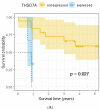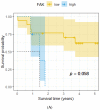THSD7A Positivity Predicts Poor Survival and Is Linked to High FAK Expression and FGFR1-Wildtype in Female Patients with Squamous Cell Carcinoma of the Lung
- PMID: 37445817
- PMCID: PMC10342182
- DOI: 10.3390/ijms241310639
THSD7A Positivity Predicts Poor Survival and Is Linked to High FAK Expression and FGFR1-Wildtype in Female Patients with Squamous Cell Carcinoma of the Lung
Abstract
Lung cancer is the leading cause of cancer-related deaths in the western world, with squamous cell carcinoma being one of the most common histological subtypes. Prognostic and predictive markers are still largely missing for squamous cell carcinoma of the lung (LSCC). Several studies indicate that THSD7A might at least play a role in the prognosis of different tumors. FAK seems to play an important role in lung cancer and is discussed as a potential therapeutic target. In addition, there is evidence that FAK-dependent signaling pathways might be affected by THSD7A. For that reason, we investigated the role of THSD7A as a potential tumor marker in LSCC and whether THSD7A expression has an impact on the expression level of FAK. A total of 101 LSCCs were analyzed by immunohistochemistry using tissue microarrays. THSD7A positivity was associated with poor overall survival in female patients and showed a relation to high FAK expression in this subgroup. To our knowledge, we are the first to report these correlations in lung cancer. The results might be proof of the assumed activation of FAK-dependent signaling pathways by THSD7A and that as a membrane-associated protein, THSD7A might serve as a putative therapeutic target in LSCC.
Keywords: FAK; LSCC; THSD7A.
Conflict of interest statement
The authors declare no conflict of interest.
Figures






Similar articles
-
The Role of SCARA5 as a Potential Biomarker in Squamous Cell Carcinoma of the Lung.Int J Mol Sci. 2024 Jul 4;25(13):7355. doi: 10.3390/ijms25137355. Int J Mol Sci. 2024. PMID: 39000462 Free PMC article.
-
THSD7A Positivity Is Associated with High Expression of FAK in Prostate Cancer.Diagnostics (Basel). 2023 Jan 7;13(2):221. doi: 10.3390/diagnostics13020221. Diagnostics (Basel). 2023. PMID: 36673031 Free PMC article.
-
SCARA5 Is Overexpressed in Prostate Cancer and Linked to Poor Prognosis.Diagnostics (Basel). 2023 Jun 29;13(13):2211. doi: 10.3390/diagnostics13132211. Diagnostics (Basel). 2023. PMID: 37443605 Free PMC article.
-
Expression of fibroblast growth factor receptor 1, fibroblast growth factor 2, phosphatidyl inositol 3 phosphate kinase and their clinical and prognostic significance in early and advanced stage of squamous cell carcinoma of the lung.Int J Clin Exp Pathol. 2015 Sep 1;8(9):9760-71. eCollection 2015. Int J Clin Exp Pathol. 2015. PMID: 26617686 Free PMC article.
-
Fibroblast growth factor receptor 1 and 3 expression is associated with regulatory PI3K/AKT kinase activity, as well as invasion and prognosis, in human laryngeal cancer.Cell Oncol (Dordr). 2018 Jun;41(3):253-268. doi: 10.1007/s13402-017-0367-z. Epub 2018 Jan 3. Cell Oncol (Dordr). 2018. PMID: 29299828
Cited by
-
Specific antigens in malignancy-associated membranous nephropathy.Front Med (Lausanne). 2024 Apr 15;11:1368457. doi: 10.3389/fmed.2024.1368457. eCollection 2024. Front Med (Lausanne). 2024. PMID: 38686366 Free PMC article. Review.
-
The Role of SCARA5 as a Potential Biomarker in Squamous Cell Carcinoma of the Lung.Int J Mol Sci. 2024 Jul 4;25(13):7355. doi: 10.3390/ijms25137355. Int J Mol Sci. 2024. PMID: 39000462 Free PMC article.
-
THSD7A as a novel prognostic factor for colorectal carcinoma.BMC Gastroenterol. 2025 Mar 17;25(1):179. doi: 10.1186/s12876-025-03775-5. BMC Gastroenterol. 2025. PMID: 40098080 Free PMC article.
References
-
- Socinski M.A., Obasaju C., Gandara D., Hirsch F.R., Bonomi P., Bunn P.A.J., Kim E.S., Langer C.J., Natale R.B., Novello S., et al. Current and Emergent Therapy Options for Advanced Squamous Cell Lung Cancer. J. Thorac. Oncol. Off. Publ. Int. Assoc. Study Lung Cancer. 2018;13:165–183. doi: 10.1016/j.jtho.2017.11.111. - DOI - PubMed
MeSH terms
Substances
LinkOut - more resources
Full Text Sources
Medical
Miscellaneous

